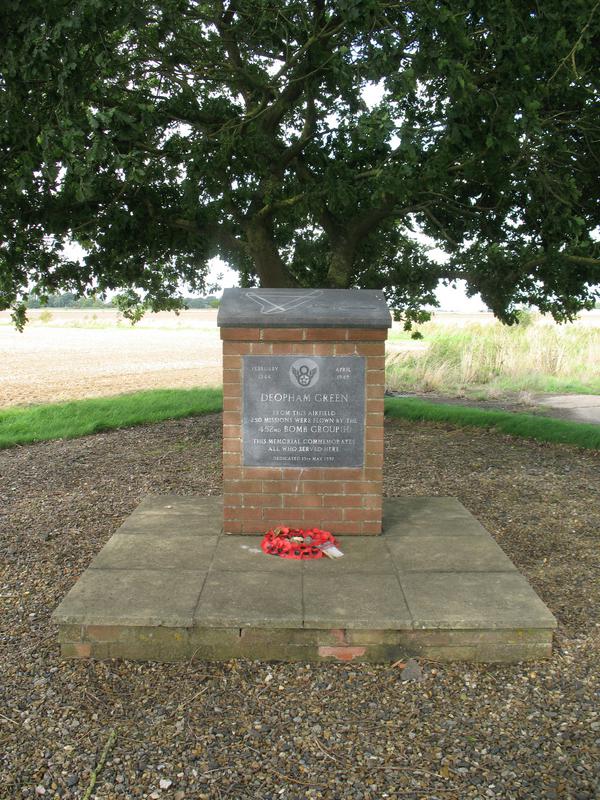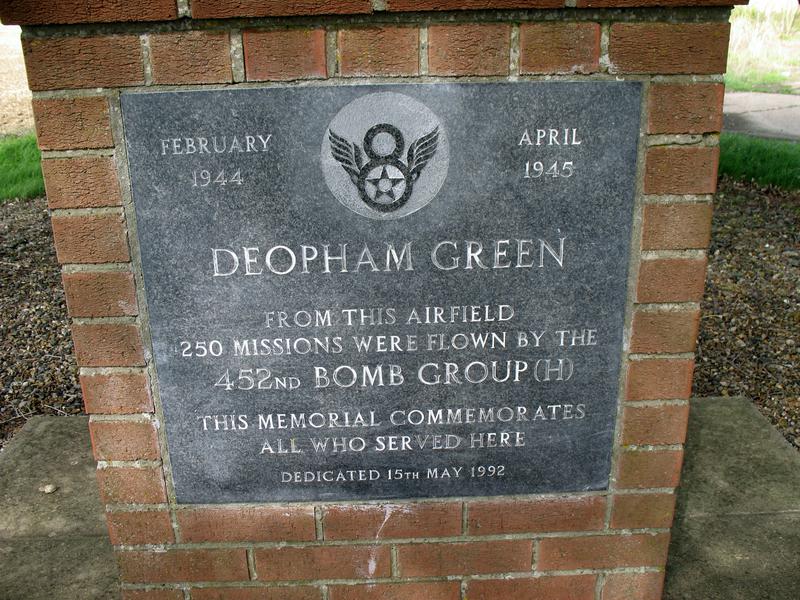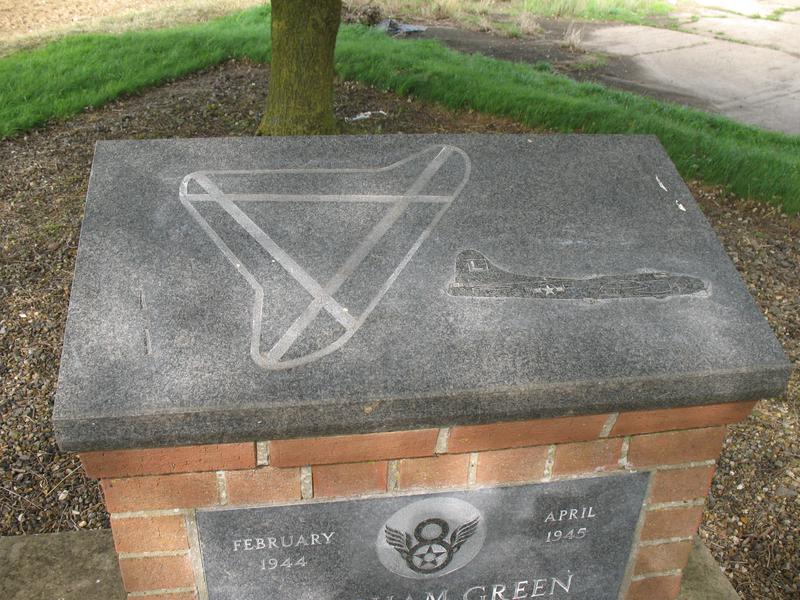452nd BG Memorial
Details:
On the east side of the road and is between two trees.
A red-bricked wall with and sloping top made of grey stone, which displays a map of the layout of the airfield's runways and an outline of a B-17 Fortress. On the front face of the wall, a plaque made also from grey stone, displays the inscription in English in white lettering and also features the insignia of the 8th Air Force. The memorial commemorates all airmen of the 452nd Bomb Group who served in the former airfield from February 1944 to April 1945.
RAF Deopham Green was built in 1942 and 1943 for the USAAF and assigned the designation Station 142. The airfield was opened on 3 January 1944 and was used by the United States Army Air Forces Eighth Air Force 452d Bombardment Group (Heavy), which arrived at Deopham Green from Walla Walla AAF Washington. The 452nd was assigned to the 45th Combat Bombardment Wing, and the group tail code was a "Square-L". Its operational squadrons were:
- 728th Bombardment Squadron (9Z)
- 729th Bombardment Squadron (M3)
- 730th Bombardment Squadron (6K)
- 731st Bombardment Squadron (7D)
The group flew Boeing B-17 Flying Fortresses as part of the Eighth Air Force's strategic bombing campaign.
The 452nd BG entered combat on 5 February 1944 with an attack against aircraft assembly plants at Brunswick. It was engaged primarily in bombardment of strategic targets, including the marshaling yards at Frankfurt, aircraft assembly plants at Regensburg, aircraft component works at Kassel, the ball-bearing industry at Schweinfurt, a synthetic rubber plant at Hanover, and oil installations at Bohlen.
First Lieutenant Donald Gott and Second Lieutenant William E Metzger Jr were each awarded the Medal of Honor posthumously for remaining with their aircraft crippled during a mission over Germany on 9 November 1944. Lieutenant Gott was at the controls of a B-17 when it was hit by anti-aircraft fire, three engines being immobilized, a fire starting in the cockpit, and the radio operator and engineer being seriously wounded. Although faced with the imminent explosion of his bomb-laden aircraft, Lieutenant Gott, after conferring with his co-pilot, Lieutenant Metzger, decided to continue to the target.
Then, after dropping their bombs, Lieutenant Gott made for the Allied lines to attempt to put the crippled Fortress down to save the life of the radio operator who had by now lost consciousness. Although ordered to bail out with the rest of the crew, the co-pilot chose to remain with Lieutenant Gott but, as he prepared to let down into a field the B-17 exploded killing all three crew members.
In addition to strategic missions, the 452nd supported ground forces and carried out interdictory operations. They helped prepare for the invasion of Normandy by hitting airfields, V-weapon sites, bridges, and other objectives in France. The group struck coastal defenses on D-Day 6 June 1944 and bombed enemy positions in support of the breakthrough at Saint-Lô in July and the offensive against Brest in August and September 1944. Later in September, it assisted the Operation Market-Garden (the airborne attack on the Netherlands), hit enemy communications in and near the combat zone during the Battle of the Bulge, December 1944 - January 1945, and bombed an airfield in support of the airborne assault across the Rhine in March 1945.
The group received a Distinguished Unit Citation for action on 7 April 1945 when, despite vigorous fighter attacks and heavy flak, it accurately bombed a jet-fighter airfield at Kaltenkirchen. The 452nd Bomb Group flew its last combat mission of World War II [in Europe] on 21 April 1945, striking marshaling yards at Ingolstadt.
The group flew a total of 250 missions from Deopham Green during the war, losing 110 of its bombers in the course of these operations. Indeed, the group suffered particularly heavy losses during the spring of 1944, at that time sustaining one of the highest rates of loss of any Fortress-equipped unit in the Eighth Air Force. The 452nd returned to the United States, being inactivated at Sioux Falls AAF South Dakota on 28 August 1945.
Source of information: Imperial War Museum War Memorials Register, en.wikipedia.org
Source of images: Imperial War Museum War Memorials Register
Monument Text:
FEBRUARY 1944 | (-8th Air Force insignia-) | APRIL 1945 |
DEOPHAM GREEN
FROM THIS AIRFIELD 250 MISSIONS WERE FLOWN BY THE 452ND BOMB GROUP (H) THIS MEMORIAL COMMEMORATES ALL WHO SERVED HERE DEDICATED 15TH MAY 1992 | ||



